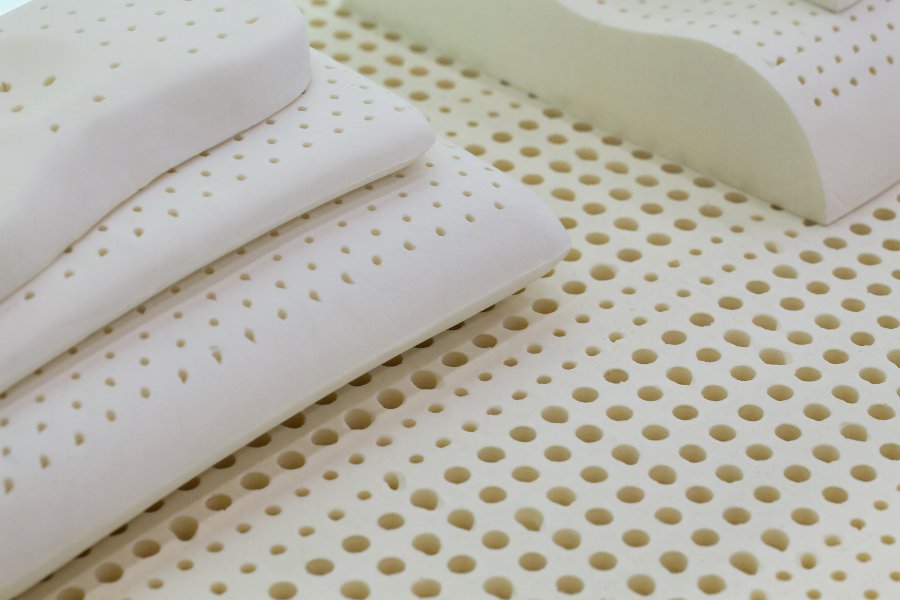Organic vs Natural Latex: The Difference You Need To Know

Curious about the difference between organic and natural latex?
We’ve done a lot of research into non-toxic furniture and this seems to be a topic people get confused on.. and rightly so. All these terms can be a bit much!
Let’s get into it.
TL;DR
The main difference between organic and natural latex is how they’re made and processed. Organic latex comes from organically grown rubber trees and is free of chemicals, certified by the Global Organic Latex Standard (GOLS). Natural latex, while also sourced from rubber tree sap, may contain added chemicals and is not certified by any standards. Organic latex is the best choice, but natural latex is a cost-effective alternative without the toxic risks of synthetic latex, which is made from petrochemicals and can off-gas toxic VOCs.

What is Latex?
To put it simply, latex is a milky substance harvested from rubber trees.
The process is actually pretty cool. It starts with small cuts made into the tree’s bark, and the liquid latex oozes out (similar to the picture above), which is then collected and processed.
How is it made?
After it’s collected it’s sent through a combination of heat and accelerators – transforming it from a liquid to a solid which is then used in products like mattresses, pillows, and furniture cushions.
Organic vs Natural Latex: Similarities & Differences
Though they sound similar, there are some key differences.

Here are some of the main differences between natural latex and organic latex:
- Organic latex is sourced from organically grown rubber trees.
- “Natural latex” is from the sap of a tree that may be treated with pesticides.
- Organic latex must meet organic standards set by third-party certifications like GOLS (Global Organic Latex Standard) while natural latex does not.
Similarities
- Sourced from the sap of rubber trees.
- Processed using the “Dunlop method” in which the latex liquid is foamed and poured into a mold and then run through a vulcanization oven.
- Sometimes either form might be finished with the “Talalay Method”- in which the latex is vacuumed of air and then frozen.
The word “natural” is a highly unregulated term across almost all industries including food, furniture, clothing, etc., and can mean many different things.
While organic latex is the cleaner option of the two, they are both much better than synthetic latex.
The Synthetic Sibling: Synthetic Latex
What is synthetic latex?
Synthetic latex, made from petrochemicals, can off-gas volatile organic compounds (VOCs) leading to symptoms like headaches and respiratory issues.
Some people might experience allergic reactions or skin irritations due to the chemicals used in its production.
Certain chemicals in synthetic latex, such as phthalates, have been linked to endocrine disruption and potential carcinogenic risks.
Whether you’re striving for a non-toxic home or not, avoid synthetic latex.

Which Latex To Choose
If you’re seeking a balance between comfort, durability, and cost, natural latex might be the ideal choice.
You’ll get the elasticity and support of latex but unfortunately, it may contain some synthetic additives.
However, organic latex is the best option.
Organic latex stands out as the better choice because it contains no toxic chemicals and is super comfortable.

How to Identify Each Type
Organic Latex
When buying organic latex, always make sure the product has the third-party certification, Global Organic Latex Standard (GOLS).
Just look for the label below

This is one of the most recognized certifications for organic latex. GOLS ensures that the latex product contains more than 95% certified organic raw material.
Natural Latex
Natural latex is easy to spot as it is normally clearly labeled on the product. If it is natural or organic, you will know. It tends to be a good selling point for companies 🙂
Synthetic Latex
You probably won’t see any latex identify itself as “synthetic latex”. It will actually not specify a specific type at all, just “latex”.
Alternatives to Latex
If you’re exploring alternatives to organic or natural latex, there are other eco-friendly fills like:
- Organic Cotton
- Organic Wool
- Organic Kapok
- Natural Coconut Coir (Coconut Husk Fiber)
- Hemp

Final Thoughts
In the debate of organic latex vs. natural latex… organic latex takes the cake.
However, natural latex is still a better choice than synthetic latex.
So next time you’re shopping for that perfect sofa or pillow, remember the differences and choose what aligns best with your needs.






